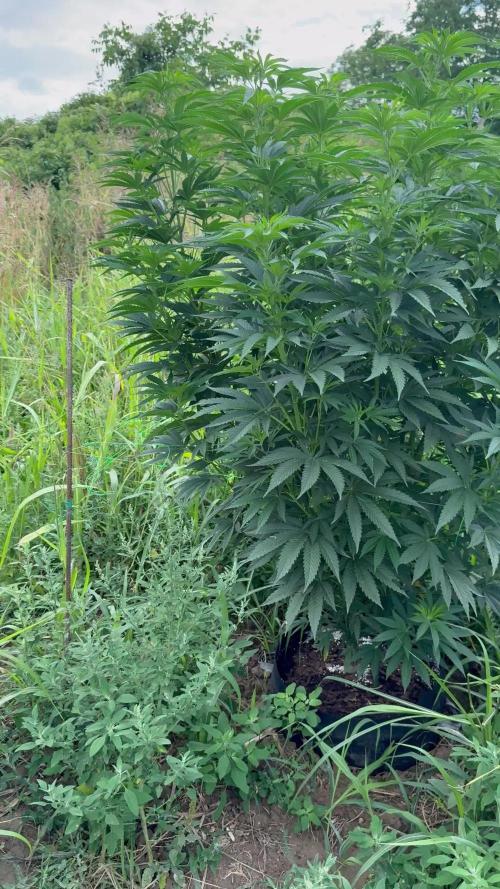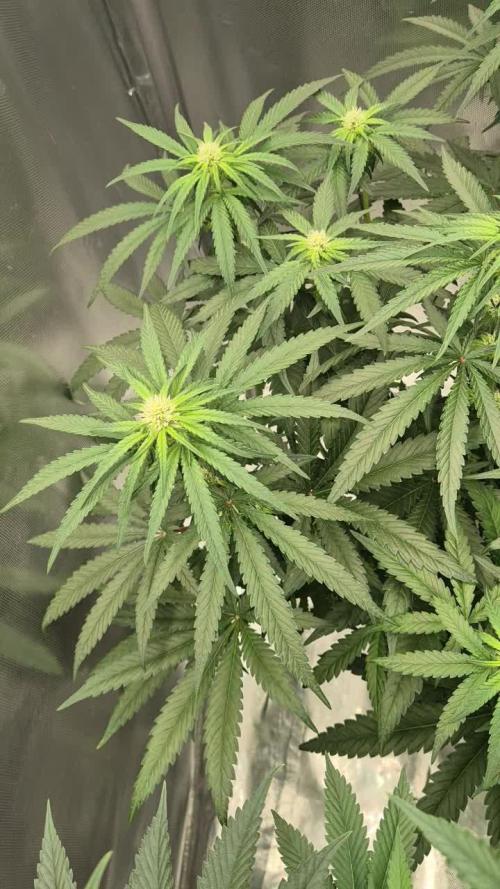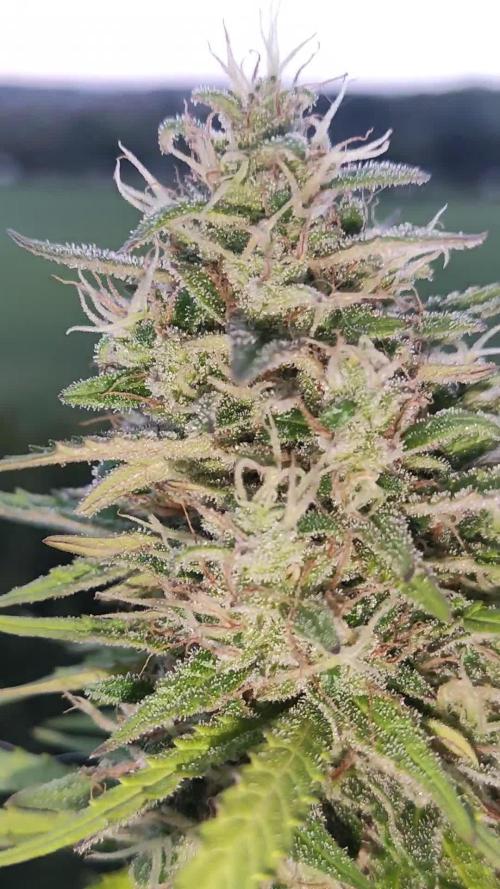The Grow Awards 2026 🏆 



























Likes
4
Share


@LoganatorDude
Follow
I did her second tie-down on day 22 actually.
Day 24- I’m okay with the fan leaf laying on the surface for *now.* Just because I live in a high, dry desert with a consistent RH at around 20-25%. And also, because the top quarter inch of soil is dry. However I will probably be propping it up with something tomorrow morning.
Day 25- finally I decided to fold down the rim of the pot for more light!
Likes
6
Share


@Grandillustrator
Follow
Ended up with just over and oz between the two plants in the end like I said wasn’t expecting much off the as spent 2-3 weeks on the window ledge as seedlings :( overall easy grow but hate having to use the HPS
Likes
50
Share


@Reyden
Follow
La White Runtz ha raggiunto quasi 80 cm di altezza dando precedenza al gambo principale e meno ai rami laterali, nessuna dei semi di Anesia è stato sottoposto ad allenamento 🏋️♂️ e finiranno il ciclo così, entrano nella terza settimana di fioritura, ho aumentato a 3ml al litro di Canna Terra Flores salendo a 1650 circa e cercherò di diminuire azoto dalla prossima volta…ci vediamo nei prossimi aggiornamenti 😎🤞✨💚🌱
Likes
49
Share


@Wastent91
Follow
Ehi ragazzi come va tutto bene? A me benone! Cosa posso dire, questa settimana ho raccolto la purple ed ora sta seccando, invece questa ragazza ha un odore speziato davvero intenso, appena mi avvicino e la sfioro l odore mi rimane impregnato e tutti in casa sanno che sono andato a prendermi cura delle mie bambine! Sembra che i fiori si stiano ingrossando abbastanza bene, sono proprio distribuite come delle pigne su un albero, il loro peso sta iniziando a farla piegare a destra e sinistra, per ora ho solo tentato di legare la cima principale in modo che nn si ribalti del tutto..😼 Ha davvero delle cime dense e mi aspetto grandi cose da questa nuova genetica premiata della Fastbuds, che sforna come sempre dei prodotti impressionanti!! 🤩
Devo ricordare che tutto questo non sarebbe possibile se non avessi una luce davvero pazzesca della Mars hydro che come sempre è grazie a lei che le ragazze danno il meglio di loro! Andate e compratela subito ve la consiglio caldamente ma perché davvero da dei risultati impressionanti, basta vedere i miei ultimi diari la differenza con quelli precedenti si nota! Grazie di tutto e buon 420 a tutti! Spero che i miei contenuti vi piacciano e continuate a seguirmi! 😼🙏😆🌱🌿🌲😻😻
Likes
15
Share


@Radagast_
Follow
30.07.
White Runtz
Day 92#
The plant was at the end of its thirteenth week yesterday and slowly started to enter preflower.
She was fed yesterday, and the next two waterings only use clean water to eat what's in the ground, and I'm switching to bloom and boost so she doesn't stretch too much...there's enough nitrogen for stretching, if she needs it, let her pull it out of the leaves.
The weather has returned to normal with the fact that the nights are a little colder, going up to 14 c
Stay High and Keep Growing!!!
Likes
10
Share


@BodyByVio
Follow
This week I Supercrop all the plants and spred them out over both lights. One more week of Veg and they are ready to explode
Check me out on Instagram @growmorestressless
Likes
8
Share


@KratkyGrow
Follow
3/3 Female!
These girls are looking beautiful right now!
They are all very small and compact but each looks pretty dense. I expect some significant stretch in the next week or two.
The main stems for all are thick and look very healthy, roots all look fantastic, I might have missed when I topped one of them. (as a reminder this is my first time topping)
The plant which forked itself looks pretty nice too, and just started to show female. I still think that plant is the most interesting since it grew that way on it's own.
I don't want to get ahead of myself, but I've fed these girls more than any other grow I've done (which to be fair is not many) but I think they might come out as my best harvest yet. I have a really good feeling about these.
Harvest should be right around X-Mas too!
This week is WEEDSGIVING! I think I'll try to make a mid week update to share some of the fun.
Likes
14
Share


@TOMI08
Follow
142.nap
A trainwreck szépséges😁😁a héten megfogom ajándékozni őket egy kis vitaminnal💚💚💚
Mit gondolsz adjak nekik lő port?
Likes
1
Share


@Borberad
Follow
Blütewoche 3
Die Blüte ist im Gange! Die Pflanze streckt sich immer noch zaghaft. Insgesamt ist die Pflanze sehr buschig und dicht gewachsen daher muss jetzt entlaubt und aufgeastet werden.Der Düngeplan bleibt unverändert.
* Zustand der Pflanze: Mäßiger Blütestretch, schöne Blütenstände.
* Wichtige Ereignisse: Zeltwechsel, Lollipoppen
* Düngung & Messwerte:
* Gießwasser: pH ca. 6,3. Leitwert 1,4 bis 2 S.
* Drain: Wir stellen sicher, dass der pH-Wert nicht unter 5,5 und nicht über 6,8 liegt und der Leitwert die +/- 500 S Abweichung einhält.
* Anpassungen: Entlauben und Lollipoppen
Likes
260
Share


@SlowpokeFuegobud
Follow
🐒 🍌 🌴🐒 🍌 🌴🐒 🍌 🌴🐒 🍌 🌴🐒 🍌 🌴🐒 🍌 🌴🐒 🍌 🌴
Welcome to week 3!! 😘
I swapped the Mars Hydro TS1000 for my Greenception GC4. It's a much better light, not that the TS1000 would be a horrible light, I would just not wanna use it when I have a GC around. 😎 I know how to use it and it has always given me tasty results! 🤤
The tepms are lower now, and with my low humidity that's just very welcome! 🙏
I overwatered them a bit, so no waterings so far this week. 😬
I made a background panel for the Kannabia ladies, that was frenetic fun for me. I hope you like it as well, growllegues!! 💚 😅
Thanks, my growmies for visiting and reading and commenting, I love reading your comments! Mwah! 😘
Thank you, @Kannabia, for sponsoring this grow, aaaaand for the amazing gift pack! 😍 I hope to make you proud! 🧡
Grower's love!! 💚
__________________________________________________________________
https://www.kannabia.com/en/feminized-cannabis-seeds/monkey-grease
Monkey Grease
At Kannabia Seeds we have put all our effort into bringing out our own feminized Monkey Grease, a cross between Monkey Grease x White Widow, focusing above all on giving it its own personality in flavor and aroma (frankly unmistakable).
Its own personality
At Kannabia Seeds we have put all our effort into bringing out our own feminized Monkey Grease, a cross between Monkey Grease x White Widow, focusing above all on giving it its own personality in flavor and aroma (frankly unmistakable) and, of course, in Highly demanded characteristics, such as high resistance to diseases and pests, and adaptability to all types of growing conditions, making it close and easy to grow to the widest possible range of growers. The result is a really powerful and versatile indica-sativa marijuana seed, with a powerful relaxing effect, ideal for those moments when you want to disconnect from the madding crowd.
Cultivation of Monkey Grease
Which cultivation method would be most appropriate for this variety? Good question… and one that is easy to answer. Its versatility and adaptability make it a true all-rounder, with remarkably uniform results, whether you choose SOG, SCROG, hydroponics or guerrilla growing. Moreover, we invite you to experiment and play, varying the techniques from moment to moment, and to draw your own conclusions. We are convinced that in all cases, apart from minor variations, the results will always be optimal, giving remarkable yields and in a short time.
Attention should be paid to its high bud production, which can be fat, dense and heavy, although its sturdy branches are able to bear heavy loads without major problems. If you are a fan of extractions, our Monkey Grease is also optimal, given its high production of caramelised resin.
If it is already amazingly productive indoors, this variety excels on its own merits outdoors, where it can easily reach 200 cm in height, and can reach between 700 and 800 grams per plant.
It is therefore an easy and grateful plant, which demands little from its gardeners, making do with simple basic care, and with little or no propensity to develop diseases or mildew, or to attract pests (despite its striking aroma!).
Taste and effect of Monkey Grease
Our Monkey Grease stands out first and foremost because of its powerful, strong smell, which is hard to camouflage. A penetrating aroma that unfolds, in a balanced way, on the palate in the form of a wide range of spicy and sweet flavours, reminiscent of wild honey, nougat and cinnamon, and distant notes of milk chocolate. A delicious treat to be savoured calmly, without haste, as a preamble to its pleasant effect: extremely relaxing and narcotic, powerful, ideal for meditation and moments of introspection and meditation.
Don’t be in a hurry with Monkey Grease. It can be your perfect ally to treat those stress and anxiety problems, but for that you must let yourself go, surrender to its charms, especially if you are inexperienced.
________________________________________________________
Setup:
60x60x180 cm Zelsius
Greenception GC4 128W
4 Cluster OSRAM + CREE LEDs (380, 455, 630, 660, 720, 760nm)
6400k (cold-white to cover the basic load during the growth)
2100k (warm-white to cover the basic load during the blossom)
The module groups can be switched individual as follows:
⬤ Module I: growth 1x 32 watt
⬤ Module II: full spectrum: 2x32 watt
⬤ Module III: Bloom: 1x 32 watt
⬤ Module I is optimized for the growth phase. A relatively high amount of blue and white support a dense growth.
⬤ Module II suits for the growth as well as blooming phase. Optimal plant light full spectrum.
⬤ Module III is optimized for the bloom. A high portion of red and an additional infrared push.
Mill's Nutrients
Plagron Growmix
Carbon Active Granulate 240cm³/h
tab water pH 8 - EC 0,25 with Calmag to 0,5
Advanced Hydroponics pH minus Grow + Bloom to pH 6.5 💧
🐒 🍌 🌴🐒 🍌 🌴🐒 🍌 🌴🐒 🍌 🌴🐒 🍌 🌴🐒 🍌 🌴🐒 🍌 🌴
Likes
16
Share


@XoticGROW666
Follow
NICE BLACK-OUT FADE TIPS BURN HERE & THERE CUD AVE TAKEN HER XTRA MORE WK BUT THE OUTDOOR WEATHER WAS TOO RISKY!!
Likes
73
Share


@MisterZ
Follow
Bonjour les amis,
Pas de changement morphologique cette semaine mais la résine est apparue en même temps qu'une légère odeur.😻
M.
Processing
Likes
21
Share


@Onlypotent420
Follow
Hi all,
Grow area updates:
Nothing major far as area is concerned added Some yoyo’s to the net so it can be raised and lowered easily now. I also noticed I had been following ghp feeding schedule for a recirculating system when mine is drain to waste. Didn’t have in adverse effects on the plants at all actually think they loved it tbh. But I’ll notice the ppm difference on these future updates. I was using way more nutrients then what was needed. Now I get to save money lol.
Blue dream auto:
Def has the faint smell of flowering cannabis now. The branching power from the mixing blue dream and already branchy plant with the ruderalis is def perfect for a scrog set up when you trying to maximize the your yield off one plant. I had to visit the tent 3 times this week to re tuck her down. Did the last tuck Thursday so what you are seeing from the pics today is three days of growth. Crazy!!!! She sitting at about 900 ppm And that’s with cutting the the grow solution some.
Master kush photo:
She popped through the net mid this week and hit her first tuck under today. With how well she reacted to the femm job. I went ahead and topped on the new growth on each branch. Her branch structure is way more sturdy then autos for sure. Leaves are bigger as well. One is the size of my palm lol I have big hands so that’s awesome. She sitting at about 800 ppm and getting less bloom solution.
I’d also like to add I appreciate everyone’s advice far as set up and temp control. It was above 100°F the last couple days. And tent never got over 85 and as soon as the hotter part of the day was over we where back in the 70’s. Ima smoke one for y’all! 🤘🏾 Until next time #StayKited
Likes
13
Share


@NuttyYeti
Follow
It smells very skunky and diesely, kind of burned my eyes while harvesting it was so strong. Very excited because this was my first grow and my first harvest and it went very well.





























